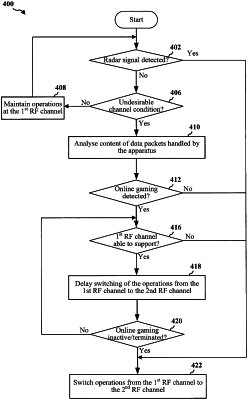| CPC H04W 72/0453 (2013.01) [H04W 72/54 (2023.01); H04W 88/08 (2013.01)] | 16 Claims |

|
1. A method of wireless communication, the method comprising:
evaluating channel conditions of a first radio frequency channel and a second radio frequency channel for an access point operating on the first radio frequency channel;
analyzing content of data packets handled by the access point;
determining whether at least one online game is running on a set of devices connected to the access point based on the analyzing of the content of the data packets;
determining whether the first radio frequency channel is able to support a bandwidth and latency requirement of the at least one online game; and
when the first radio frequency channel is able to support the bandwidth and latency requirement of the at least one online game:
delaying switching the access point from operating on the first radio frequency channel to operating on the second radio frequency channel when the at least one online game is running on the set of devices connected to the access point;
determining that the at least one online game is inactive or terminated by tracking the data packets associated with the at least one online game; and
switching the access point from operating on the first radio frequency channel to operating on the second radio frequency channel when an absence of the data packets associated with the at least one online game is tracked for a threshold length of time; and
when the first radio frequency channel is unable to support the bandwidth and latency requirement of the at least one online game, switching the access point from operating on the first radio frequency channel to operating on the second radio frequency channel.
|